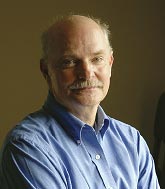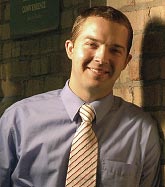

Going Global
How the U makes the world a little smaller (and that’s a good
thing).
by Brett Hullinger
On an overheated summer evening, you find yourself slumped into your
couch cushions, watching the NBA basketball playoffs. The Dallas Mavericks
are trotting out their German star, Dirk Nowitzki, along with Senegal-born
DeSagana Diop, to face off against the Phoenix Suns’ Steve Nash,
a Canadian who happens to be the league’s MVP, and their formidable
center Boris Diaw of France.
During a commercial you flip to the news and watch Mexican President
Vicente Fox addressing the Utah Legislature on how best to handle immigrants
streaming into the U.S. from Latin America. At halftime you step outside
of your suburban Salt Lake City home and wave to the next-door neighbors—a
Japanese man who was raised in Brazil, and his wife, who is British
and recently gained U.S. citizenship.
The remarkable thing about all this—the daily convergence of
people coming from and going to far-flung lands—is that it is,
well, unremarkable. The global community is here, and cultural interaction
is part and parcel of life in the 21st century. It’s no big deal,
really. And yet the divisions between cultures can, and do, lead to
conflicts with global implications. Perhaps at no time in history has
an understanding of cultures other than your own been more important
to the everyday lives of ordinary citizens.
By the time the program was approved in 2003, students
were literally lined up outside Lehning’s door. “It was
actually a little embarrassing for my colleagues,” he says, “because
every time I’d be in here having office hours, the hallway would
be filled with students waiting to see me.”
Enter the University of Utah’s International Studies program.
Launched in 2003, the program aims to “bring greater global understanding
to students and to allow students to take advantage of awareness of
this global context in their career pursuits.” In other words,
the whole world is a job market, and graduates who possess meaningful
knowledge of our world will have a leg up.
It’s clearly an appealing concept, as students have flocked to
the new International Studies program. In just over three years, nearly
450 students have declared the major, and it is now the largest non-departmental
major on campus. Utilizing a dynamic, interdisciplinary approach, the
program looks at the world from many different viewpoints, while encouraging—in
fact, requiring—cultural interaction.
 Jim
Lehning, director of the IS program and a history professor
by trade, sits in his third-floor office on the western edge of campus.
Photos of famed Impressionist painters Claude Monet and Camille Pissarro
peer down from above the desk. A small print of Monet’s “Impression,
soleil levant” hangs on the back wall. While a noisy air conditioner
strains against the summer heat, Lehning explains the impetus for developing
the program, which occurred during the 2001-2002 academic year. Jim
Lehning, director of the IS program and a history professor
by trade, sits in his third-floor office on the western edge of campus.
Photos of famed Impressionist painters Claude Monet and Camille Pissarro
peer down from above the desk. A small print of Monet’s “Impression,
soleil levant” hangs on the back wall. While a noisy air conditioner
strains against the summer heat, Lehning explains the impetus for developing
the program, which occurred during the 2001-2002 academic year.
“There were two things that happened that highlighted America’s,
and especially Utah’s, relationship to the rest of the world,”
he says. “One was 9/11, and the other one was the Winter Olympics.”
The world, in effect, had come to our doorstep, in decidedly different
but compelling ways, and the need for international studies was never
more obvious.
In addition, says Lehning, the program was simply overdue. “There
are something like 550 of these programs in American colleges and universities,”
he points out. “So it’s not a completely unknown phenomenon.”
By the time the program was approved in 2003, students were literally
lined up outside Lehning’s door. “It was actually a little
embarrassing for my colleagues,” he says, “because every
time I’d be in here having office hours, the hallway would be
filled with students waiting to see me.”
What brought them to the door varied from person to person. Some had
spent time in a country and hoped to return. One student ran an import/export
business and wanted to study the part of the world where he was doing
business. Others were aiming for the foreign service, or planned to
use the program as a stepping stone to law school or MBA programs.
Regardless of why they were drawn to the IS program, students seemed
to arrive with uncommon enthusiasm. “I started noticing,”
recalls Lehning, “when students would come in here and I would
go through the requirements of the program, they would sit up and say,
‘That’s the most exciting thing that’s happened to
me all week.’ ”
It’s easy to see why. The requirements for the major consist
of four components. First is foreign language. The B.A. requires two
years of language, with an additional year for the IS program, for a
total of three years of language study. There is no language requirement
for the B.S. degree. (About 75 percent of IS students pursue the B.A.)
Second is a set of core courses aimed at developing analytic skills
from different disciplines. This is where the interdisciplinary strength
of the program becomes evident. In the core requirements alone, students
have the opportunity to take courses in political science, history,
business, communication, literature, linguistics, philosophy, anthropology,
economics, geography, and sociology.
The third requirement—and this is the part that tends to bring
students to the edge of their seats—is an “international
experience.” This is typically, though not always, a study abroad
program. The experience must be equivalent to one semester’s engagement
with another culture. “So going to Paris for spring break, walking
around the Louvre, and writing a paper about it is not going to fulfill
the requirement,” quips Lehning.
Finally, the degree requires a set of upper division courses with either
a global studies track or an area studies track, such as Asian Studies.
Here is where practically the entire university course catalog is open
to students. Considering that the poetry of a region can shape its culture
just as much as its politics, students may choose a variety of courses
across many disciplines.
This type of flexibility is particularly attractive to students worried
about being pigeonholed into a narrowly defined curriculum—which
was part of the appeal for Dave Smurthwaite, who began pursuing an International
Studies degree even before it existed.
 Dave
Smurthwaite pulls up a chair in the glass-enclosed conference
room of Jibe Media, located in downtown Salt Lake, a full-service ad
agency where he works as an art director. He is in his mid-twenties
and looks casually hip in a T-shirt and jeans. Raised in Provo, Smurthwaite
had his first international experience via a two-year religious mission
to Milan, Italy. The time away opened his eyes to the world. Dave
Smurthwaite pulls up a chair in the glass-enclosed conference
room of Jibe Media, located in downtown Salt Lake, a full-service ad
agency where he works as an art director. He is in his mid-twenties
and looks casually hip in a T-shirt and jeans. Raised in Provo, Smurthwaite
had his first international experience via a two-year religious mission
to Milan, Italy. The time away opened his eyes to the world.
“I came to realize, quickly, that the environment in which I’d
been raised wasn’t the only thing out there, wasn’t the
norm,” he says. “It really brought to my mind the fact that
this international experience was truly the best education that I’d
had in my life up to that point.”
Upon returning from his mission in 2000, he enrolled at the University
of Utah. At the time, the International Studies program was not even
in the works, and he promptly took up residence in the business school.
“I was interested in international business,” says Smurthwaite.
“But I was much more interested in international than I was in
business.”
To that end, Smurthwaite made several attempts to add some overseas
experience to his business education, only to grow increasingly frustrated
in the process. In the summer of 2002 he did a marketing internship
in Bulgaria. “But the business program didn’t want to accept
my work in Bulgaria as any type of credit toward my business degree,”
he says. “So that frustrated me.”
At the same time Smurthwaite was working on his undergraduate degree,
his wife, Marisa, was at the U pursuing a master’s degree in the
French department. She wanted to spend a year in France, so Dave found
an international business school there that would transfer his credits
back to the U.
Once again, however, the credits would not apply toward his business
degree, so the trip to France appeared to be out of the question. “I
didn’t want to go away for a year, study, and have it all count
for nothing,” Smurthwaite says.
Fortunately, he soon found out about the new International Studies
program being developed at the U. It hadn’t been formalized yet,
but it was on track for approval, and a curriculum had already been
formulated. It was just the thing he was looking for.
So he took a chance. Dave started following the International Studies
curriculum, and left with Marisa for France in August 2002. In the spring
of 2003, he received a message from Jim Lehning: The IS program had
been approved.
Smurthwaite came back in May of that year and was instantly rewarded
for his work overseas. Instead of having two more years to earn a business
degree, he completed just one more year of study, and in 2004 was one
of the first graduates to take home an International Studies degree
from the U.
It has served him well—not just the degree itself, but the cultural
experiences that have resulted from it. “It has very much shaped
the way that I communicate with people, my general perspective with
people,” says Smurthwaite. “There are so many elements that
make up a person, and so much of that is cultural. It’s been invaluable
to me in all aspects of my life.”
Such talk is music to Jim Lehning’s ears. “I’ve been
teaching at a university for 29 years,” he says, “and that’s
the payback, that someone walks out of your class with a better understanding
of the world than when they walked into it. Not that they agree with
you, but that they are just better able to understand things.”
Right now there are 388 students at the U trying to better understand
their world through the International Studies program. And more are
arriving every day. Upon graduation they will enter a world that is
forever getting smaller, and with any luck, a little less foreign.
—Brett Hullinger is a freelance writer living in Salt Lake
City.
A Global Tour of the U: a sampling of other
international programs at the U
Return to fall 2006 table of contents
|



